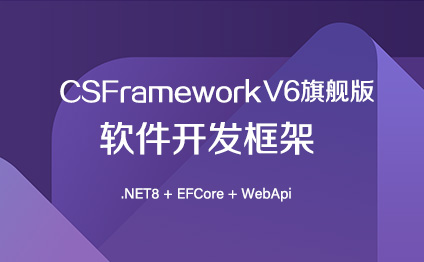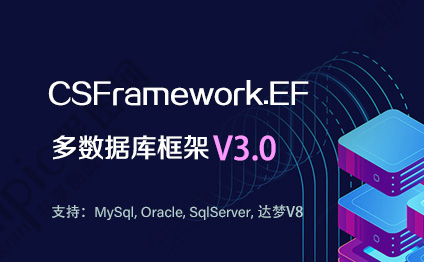[下载]DataSet Remoting(DataSetSurrogate)
将DATASET、DATATABLE序列化
使用说明:
CSharp DataSetSurrogate Usage Sample
====================================
TestSurrogate is the client application. It calls DSServer, which is the server component.
I designed DSServer to be hosted in COM+, but it can be remotely hosted in any manner desired.
Both TestSurrogate and DSServer import DataSetSurrogate class, this is the class that performs the
serialization of the DataSet.
So that both the client and server use same instance of the DataSetSurrogate class, I setup
the class to have a strong name using a key file (DataSetSurrogate.snk) and it needs to be added to the GAC.
All projects are build using Visual Studio .NET 2003.
Build the projects in the following order:
1. Build DataSetSurrogate project.
2. Open up the Visual Studio .NET 2003 Command prompt and CD to C:\SurrogateSample\CSharp folder.
3. Run gacutil to add DataSetSurrogate to the GAC, like so:
C:\SurrogateSample\CSharp>gacutil /if .\DataSetSurrogate\bin\Release\DataSetSurrogate.dll
Microsoft (R) .NET Global Assembly Cache Utility. Version 1.1.4322.573
Copyright (C) Microsoft Corporation 1998-2002. All rights reserved.
Assembly successfully added to the cache
4. Build DSServer project.
5. Run gacutil to add DSServer to the GAC:
C:\SurrogateSample\CSharp>gacutil /if .\DSServer\bin\Release\DSServer.dll
Microsoft (R) .NET Global Assembly Cache Utility. Version 1.1.4322.573
Copyright (C) Microsoft Corporation 1998-2002. All rights reserved.
Assembly successfully added to the cache
6. Run regsvcs on DSServer to add the component to COM+:
C:\SurrogateSample\CSharp>regsvcs .\DSServer\bin\Release\DSServer.dll
Microsoft (R) .NET Framework Services Installation Utility Version 1.1.4322.573
Copyright (C) Microsoft Corporation 1998-2002. All rights reserved.
Installed Assembly:
Assembly: C:\SurrogateSample\CSharp\DSServer\bin\Release\DSServer.dll
Application: DSServer_CS
TypeLib: C:\SurrogateSample\CSharp\DSServer\bin\Release\DSServer.tlb
7. If you are testing on a Windows 2003 machine, open Component Services
snap-in (Administrative Tools) and the open property sheet for DSServer_VB
application. Select the Identity tab and choose Local Service for the account.
8. Build TestSurrogate project last, as it references both DSServer and DataSetSurrogate classes.
DataSet Remoting
Authors:
File: DataSetRemoting.doc
Status: Draft
Last Change: 9/15/2003 11:28:00 PM
Printed: 9/10/2003 12:55 PM
Keywords: WEBDATA, MANAGED, PROVIDER
1. Introduction
The .Net framework provides Remoting mechanisms for sending/receiving objects across appdomains, processes or machines. DataSet instances can be accessed via Remoting. Generally, Remoting is more efficient than WebServices. But for large DataSets, that is not the case. Accessing large DataSets over WebServices has better performance characteristic than remoting. The memory consumed by the system during remoting increases rapidly with the dataset size, it may not scale well for large datasets. This document describes a solution that can be used to optimize DataSet remoting. It improves both memory consumption and end to end latency.
2. Description
DataSet serializes its content as XML for the purposes of remoting. This works well for small DataSet (cumulative count of rows in all tables is less than 10000 rows). However, this does not scale well for large DataSet, and results in increased memory usage and slow performance. To improve DataSet remoting performance, DataSet contents can be copied to a surrogate class that is structured such that it can be easily and efficiently remoted. This gives good performance for small as well as large DataSet.
3. Remoting DataSet
We first describe how to remote an untyped DataSet and subsequently in the next section we will describe how to remote a typed DataSet.
Remoting a DataSet using a custom class involves doing the following:
1. Create a surrogate class for
- DataSet
- DataTable
- DataColumn.
2. All surrogate classes are marked as [Serializable], so it does not have to implement ISerializable for custom remoting.
3. The surrogate class is primarily designed for remoting and it is structured accordingly. All its members are serializable, i.e. their types are either the built-in types or belong to a serializable class.
4. The surrogate class will provide
- A constructor that accepts as input the object that is being surrogated - in this case the object being surrogated is DataSet.
- A method that constructs back the object that is being surrogated [DataSet in this case] from the surrogate object.
The client and server code would look like the following:
/**
Server code
**/
public DataSetSurrogate GetDataSetSurrogate() {
DataSet ds = new DataSet();
ds.ReadXmlSchema(“Northwind.xsd”);
ds.ReadXml(“Northwind.xml”);
return new DataSetSurrogate(ds);
}
/**
Client code
**/
DataSetSurrogate dss = GetDataSetSurrogate();
DataSet ds = dss.ConvertToDataSet();
3.1 DataSetSurrogate class
DataSetSurrogate class is designed to be a surrogate for the DataSet class. It has a constructor that accepts DataSet as an argument and initializes itself with the content of the passed DataSet. It provides ConvertToDataSet() method that returns an equivalent DataSet instance.
The portion of the class definition that defines its members is given below:
[Serializable]
public class DataSetSurrogate : ISerializationSurrogate {
private string _datasetName;
private string _namespace;
private string _prefix;
private bool _caseSensitive;
private CultureInfo _locale;
private bool _enforceConstraints;
private ArrayList _fkConstraints; of foreign key constraints
private ArrayList _relations;
private Hashtable _extendedProperties;
private DataTableSurrogate[] _dataTableSurrogates;
}
3.1.1 Class Members
The DataSetSurrogate class members are either a collection of some kind or are simple built-on types. In this section we describe the members whose type is a kind of a collection (i.e. ArrayList, HashTable or Array)
3.1.2 ForeignKeyConstraints
Foreign Key constraint contains information about the child table, child columns, parent table and the associated primary/unique key. Unlike other constrains that are confined to a single table (i.e. Unique constraint) this constraint is across tables. The ForeignKeyConstraint collection gets serialized as part of DataSetSurrogate, while all other constraints get serialized as part of DataTableSurrogate.
Format of each item in the list
String ConstraintName
ArrayList parentInfo {ParentTableIndex, ParentColumnOrdinal(s)}
ArrayList childInfo {ChildTableIndex, ChildColumnOrdinal(s)}
Boolean AcceptRejectRule, UpdateRule, DeleteRule
HashTable ExtendedProperties
Where: the words in italics indicate the type of the corresponding value. The list only contains the value, their corresponding type is known to the code that encodes/decodes the ForeignKeyConstraint object.
3.1.3 Relations
DataSet supports creating of DataRelation on DataTables. The DataRelation associates two tables in a parent - child relationship.
Format of each item in the list
String RelationName
ArrayList parentInfo {parentTableIndex, primaryKeyOrdinal(s)}
ArrayList childInfo {ChildTableIndex, ForeignKeyOrdinals}
Boolean IsNested
HashTable ExtendedProperties
Where: the words in italics indicate the type of the corresponding value. The list only contains the value, their corresponding type is known to the code that encodes/decodes the DataRelation object.
3.1.4 ExtendedProperties
This is a simple HashTable that contains the ExtendedProperty name as the key and its corresponding value is the property’s value.
3.1.5 DataTableSurrogates
Similar to a DataSet that contains a collection of DataTable, DataSetSurrogate contains an array of DataTableSurrogate object(s). DataTableSurrogate is marked serializable and its remoting is automatically taken care of by.NET platform.
3.2 DataColumnSurrogate
DataColumnSurrogate class is designed to be a surrogate for the DataColumn Class. It has a constructor that takes a DataColumn as an argument and initializes itself with the content of the passed DataColumn. DataColumnSurrogate provides ConvertToDataColumn() method that returns an equivalent DataColumn instance.
The class’s members are given below:
[Serializable]
public class DataColumnSurrogate {
private string _columnName;
private string _namespace;
private string _prefix;
private MappingType _columnMapping;
private bool _allowNull;
private bool _autoIncrement;
private long _autoIncrementStep;
private long _autoIncrementSeed;
private string _caption;
private object _defaultValue;
private bool _readOnly;
private int _maxLength;
private Type _dataType;
private string _expression;
private Hashtable _extendedProperties;
}
3.2.1 Class Members
All DataColumnSurrogate class members are of simple built-in types. The composition of the ExtendedProperties HashTable is similar to the construction of DataSetSurrogate’s ExtendedProperties.
3.3 DataTableSurrogate
DataTableSurrogate class is designed to be a surrogate for the DataTable class. It’s designed like the other surrogate classes. It has (1) a constructor that accepts the base object, in this case a DataTable and (2) its ConvertToDataTable() method can be used to construct an equivalent DataTable object.
The DataTableSurrogate class with only its class members is listed below.
[Serializable]
public class DataTableSurrogate {
//DataTable properties
private string _tableName;
private string _namespace;
private string _prefix;
private bool _caseSensitive;
private CultureInfo _locale;
private string _displayExpression;
private int _minimumCapacity;
private ArrayList _uniqueConstraints;
private Hashtable _extendedProperties;
private DataColumnSurrogate[] _dataColumnSurrogates;
private BitArray _rowStates;
private object[][] _records;
private Hashtable _rowErrors;
private Hashtable _columnsInError;
}
3.3.1 Class Members
The DataTableSurrogate class members are either a collection of some kind or are simple built-in types. In this section we describe the members whose type is a kind of collection (i.e. ArrayList, HashTable or Array)
3.3.1.1 UniqueConstraints
UniqueConstraint contain information about the current table and its unique key columns.
Format of each item in the list
String ConstraintName
ArrayList colInfo {ColumnOrdinal(s)}
Boolean IsPrimaryKey
HashTable ExtendedProperties
Where: the words in italics indicate the type of the encoded value.
3.3.1.2 RowStates
A DataTable contains zero or more DataRows in its DataRowCollection. For the purpose of remoting performance, the DataRow’s content is stored in the following DataTableSurrogate members
- RowStates
- Records
- RowErrors
- ColumnErrors
For optimizing remoting performance, the row content is not send as a collection of row values but as a collection of column values. RowStates is used to keep track of row’s state and its associated current and original record values. To optimize memory utilization, RowStates is a BitArray instead of an array of integers. A set of 2 bits is used to represent a single row’s state. The RowStates use the following encoding: [00]->Unchanged, [01]->Added, [10]->Modified, [11]->Deleted.
3.3.1.3 Records
Records are sent in a 2 dimensional array that contains a list of column values. As a row can have up to 2 records [original, current], the size of each column values array is twice the number of rows. Based on the row state, it knows the records associated with each row. The organization of the records is what gives DataSetSurrogate object the most performance boost during remoting.
3.3.1.4 RowErrors
RowErrors is a HashTable that contains rows that have errors. The key is the row index and the value is the row’s error message.
3.3.1.5 ColumnErrors
This is a HashTable that contains the column specific errors for the rows that has errors. The key is the row index and the value is an ArrayList with 2 items, each of which is an ArrayList. The first item identifies the column ordinals that have errors, and the second item contains the error message for the corresponding column in error.
3.3.1.6 DataColumnSurrogates
Just as DataTable contains a collection of DataColumn, DataTableSurrogate contains an array of DataColumnSurrogate objects. This is used to contain the column information for the current Table. Please see section 3.2 for more information on DataColumnSurrogate class
3.3.2 Deserialization Sequence
It is important to observe the sequence during the deserialization process. Setting of expressions on the expression columns should be delayed until the relations have been processed, otherwise setting the expression on the columns would throw exception.
4. Remoting Typed DataSet
Remoting of a typed dataset is very similar to remoting a standard dataset. The DataSetSurrogate object does not know about TypedDataSet but since, the content of both types of DataSet is the same the standard dataset retrieved from the DataSetSurrogate can be used to populate a typed dataset instance.
The following example illustrates how to construct a typical TypedDataSet instance from its corresponding DataSet instance.
/**
Server code
**/
public DataSetSurrogate GetDataSetSurrogate() {
Northwind nwds = new Northwind();
nwds.ReadXml(“Northwind.xml”);
return new DataSetSurrogate(nwds);
}
/**
Client code
**/
DataSetSurrogate dss = GetDataSetSurrogate();
Northwind nwds = new Northwind();
dss.ReadDataIntoDataSet(nwds);







